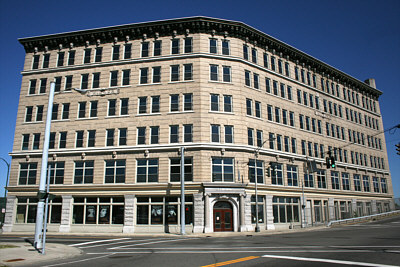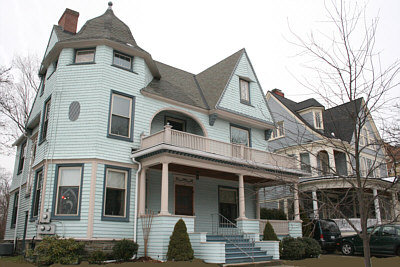An Eventful Year
A look back over a year of Preservation News.
An exhibit opened last May at the History Center, on the second floor of the Broome County Public Library. During the opening ceremony, County Executive Barbara Fiala proclaimed the month of May as "Preservation Month in Broome County."
Co-sponsored by the Southern New York chapter of the American Institute of Architects (AIA) and the Preservation Association of the Southern Tier (PAST), the exhibit was the first of what has become an annual event.
It's that time again, and on Monday, May 5, a new exhibit opens at the History Center and will run through June. Through photographs, the display highlights many local preservation issues that have been in the news over the last year - and what a year it's been!

The Kilmer Building
|
French press and crème broulee? After sitting empty for twenty years, last October an opening celebration was held at the Kilmer Building for its first new tenant, the Goldsmith. Since then renovation of the building has continued, and on First Friday, May 2, a grand opening of Binghamton's new French restaurant, "Kilmer Brasserie and Steakhouse," will take place.
Renovation work continues on Johnson City's Goodwill Theatre, and since October audiences have been entertained with performances in the renovated village firehouse and municipal building, now known as the Firehouse Stage.
In January, stainless steel diner aficionados were saddened to learn of the closing of the Red Robin, a classic 1952 "Mountain View #281" diner in Johnson City. Recently renovated and re-opened under new ownership, the Red Robin is once again bobbin' along.

Houses in the Abel Bennett Tract
|
Last September, a section of Binghamton's West Side, known as the Abel Bennett Tract, was placed on the State and National Registers of Historic Places.
After years of neglect, the O'Neil Building on Court Street, Binghamton, was demolished. The adjacent Ross Building is now scheduled to meet the same fate - two Binghamton landmarks fallen victim to demolition by neglect.
In April it was reported that bricks were falling from the Stone Opera House on Chenango Street. Currently there is a gaping hole in the wall, bricks are scattered on the sidewalk below, and pedestrian barricades block the area. This could be a good test of Binghamton's new "Vacant Property Registration Ordinance," initiated in January of this year.
The Press Building on Chenango Street in Binghamton has undergone extensive renovation, to include exterior work, redesign of the main entrance, creation of a new lobby, and remodeling of four upper floors. New tenant Coughlin & Gerhart LLP took occupancy of floors 8, 10, 11 and 12 in April, and a grand opening celebration you won't want to miss is scheduled for First Friday Art Walk, June 6.
The on-again off-again plan by Broome Community College to demolish the historic Alms House is off - - again. In April it was announced that funding has been secured for its rehabilitation.
Recently word came of a major preservation triumph for the community - Binghamton's Castle, the historic New York State Inebriate Asylum, has at long last been saved! In April, Assemblywoman Donna Lupardo announced that funding has been secured for phase one of a plan to renovate the long abandoned building for use by SUNY Upstate Medical University.
All in all, this has been an eventful year for historic preservation - very possibly the most eventful year this area has experienced in decades. Someone commented the other day that this is a good time to be a preservationist. Better yet, this is a good time to be living in the Southern Tier!
The photo exhibit opens May 5 at the History Center, on the second floor of the Broome County Public Library.
Preservation Updates

Plans move forward to commemorate the 150th anniversary of Binghamton's historic Inebriate Asylum, and last month's announcement that funding has been secured to begin renovation of the building could not have been better timed.
Each month leading up to the September 24th anniversary, this column presents excerpts from documents of the asylum's founder and first director, Joseph Edward Turner.
It is 1858: Over the last year several areas around the state have been considered as locations for the planned Inebriate Asylum. In April, Turner made several trips to Binghamton from his office in New York City. A committee of Binghamton citizens has been formed and on May 12, Turner and the committee spend the day at a proposed site on a hill just east of town, the "Lyons Farm." Soon after, the citizens of this town make Turner an offer he could not refuse.
Back in New York City, Turner calls a board meeting for May 19, where the following resolution is drafted:
"Resolved that the Trustees of the New York State Inebriate Asylum, do hereby accept as a donation from the citizens of Binghamton two hundred and fifty acres of land known as the Lyons and adjoining farms; as a site for the New York State Inebriate Asylum; and that the corresponding secretary be instructed to notify the citizens of Binghamton that the trustees of the New York State Inebriate Asylum have this day at a meeting held in the city of New York, decided to locate the above named institution in the town of Binghamton, and on the land known as the Lyons and adjoining farms." -- Board of Trustees, New York State Inebriate Asylum, May 19, 1858.
By month's end Turner makes three more trips to the new Binghamton site, and accompanying him on May 29 is his architect for the project, Isaac Gale Perry.
|

